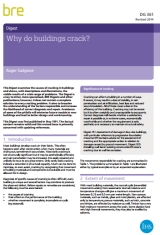Why do buildings crack? (DG 361)
BRE (Building Research Establishment) is an independent, research-based consultancy, testing and training organisation, operating in the built environment and associated industries.
Why do buildings crack? (DG 361) was first published by BRE in May 1991, and the original content largely remains valid. The current edition was published on 21 August 2014 and includes updated references. It was written by Roger Sadgrove.
Most buildings develop cracks in their fabric, often soon after construction when materials are drying out, but sometimes later. Most early cracking is not structurally significant and is easily repaired. Only rarely does cracking indicate a reduction in structural capacity.
However, diagnosis can be difficult, as every building is unique and several factors may combine to produce a defect. DG 361 examines the causes of cracking in buildings, describes a wide range of potential problems and offers complete solutions to every cracking problem. It is intended to broaden the reader’s understanding of the factors that contribute to cracking and so increase the likelihood of correct diagnosis and remediation.
It provides guidance about how to avoid pitfalls and how to reduce the likelihood of future problems in new buildings.
The contents of the 12 page digest are:
- Introduction.
- Extent of movement.
- The effect of movements: how do cracks occur?
- Diagnosis.
- Temperature changes.
- Initial drying out of moisture and wetting and drying.
- Loss of volatiles.
- Freezing and thawing of absorbed water.
- Subsurface crystallisation of soluble salts.
- Sulfate attack.
- Corrosion or oxidation of steel.
- Moisture expansion of fired clay products.
- Carbonation.
- Alkali silica reaction.
- Hydration of oxides and unstable clinker aggregates.
- Imposed load effects.
- Foundation movement.
- Vibration.
- References.
[edit] Related articles on Designing Buildings Wiki
- BRE articles on Designing Buildings Wiki.
- BRE Buzz articles on Designing Buildings Wiki.
- BRE Buzz.
- Building Research Establishment.
- Burland scale
- Cracking and building movement.
- Cracking in buildings.
- Defects in brickwork.
- Defects in construction.
- Defects in dot and dab.
- Defects in stonework.
- Foundations.
- Ground heave.
- Latent defects.
- Leaning Tower of Pisa.
- Preventing wall collapse.
- Pyrite and mica redress issues in Dail Eireann.
- Repointing.
- Settlement.
- Sinkholes.
- Subsidence.
- Underpinning.
Featured articles and news
RTPI leader to become new CIOB Chief Executive Officer
Dr Victoria Hills MRTPI, FICE to take over after Caroline Gumble’s departure.
Social and affordable housing, a long term plan for delivery
The “Delivering a Decade of Renewal for Social and Affordable Housing” strategy sets out future path.
A change to adoptive architecture
Effects of global weather warming on architectural detailing, material choice and human interaction.
The proposed publicly owned and backed subsidiary of Homes England, to facilitate new homes.
How big is the problem and what can we do to mitigate the effects?
Overheating guidance and tools for building designers
A number of cool guides to help with the heat.
The UK's Modern Industrial Strategy: A 10 year plan
Previous consultation criticism, current key elements and general support with some persisting reservations.
Building Safety Regulator reforms
New roles, new staff and a new fast track service pave the way for a single construction regulator.
Architectural Technologist CPDs and Communications
CIAT CPD… and how you can do it!
Cooling centres and cool spaces
Managing extreme heat in cities by directing the public to places for heat stress relief and water sources.
Winter gardens: A brief history and warm variations
Extending the season with glass in different forms and terms.
Restoring Great Yarmouth's Winter Gardens
Transforming one of the least sustainable constructions imaginable.
Construction Skills Mission Board launch sector drive
Newly formed government and industry collaboration set strategy for recruiting an additional 100,000 construction workers a year.
New Architects Code comes into effect in September 2025
ARB Architects Code of Conduct and Practice available with ongoing consultation regarding guidance.
Welsh Skills Body (Medr) launches ambitious plan
The new skills body brings together funding and regulation of tertiary education and research for the devolved nation.
Paul Gandy FCIOB announced as next CIOB President
Former Tilbury Douglas CEO takes helm.
UK Infrastructure: A 10 Year Strategy. In brief with reactions
With the National Infrastructure and Service Transformation Authority (NISTA).
























